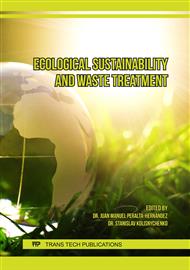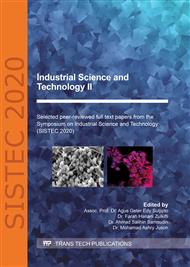[1]
A. A. Setiawan, D. Budianta, S. Suheryanto, and D. P. Priadi, Review : Pollution due to Coal Mining Activity and its Impact on Environment,, Sriwij. J. Environ., vol. 3, no. 1, p.1–5, 2018,.
DOI: 10.22135/sje.2018.3.1.1-5
Google Scholar
[2]
A. RoyChowdhury, D. Sarkar, and R. Datta, Remediation of Acid Mine Drainage-Impacted Water,, Current Pollution Reports. 2015,.
DOI: 10.1007/s40726-015-0011-3
Google Scholar
[3]
R. S. Gautama, Y. S. Novianti, and E. Supringgo, Review on In-pit Treatment of Acidic Pit Lake in Jorong Coal Mine, South Kalimantan, Indonesia,, An Interdiscip. Response to Mine Water Challenges - Sui, Sun Wang (eds), China Univ. Min. Technol. Press. Xuzhou, ISBN 978-7-5646-2437-8, p.645–649, (2014).
Google Scholar
[4]
G. Naidu, S. Ryu, R. Thiruvenkatachari, Y. Choi, S. Jeong, and S. Vigneswaran, A critical review on remediation, reuse, and resource recovery from acid mine drainage,, Environmental Pollution. 2019,.
DOI: 10.1016/j.envpol.2019.01.085
Google Scholar
[5]
J. E. Santos Jallath, F. M. Romero, R. Iturbe Argüelles, A. Cervantes Macedo, and J. Goslinga Arenas, Acid drainage neutralization and trace metals removal by a two-step system with carbonated rocks, Estado de Mexico, Mexico,, Environ. Earth Sci., 2018,.
DOI: 10.1007/s12665-018-7248-2
Google Scholar
[6]
J. Taylor, S. Pape, and N. Murphy, A Summary of Passive and Active Treatment Technologies for Acid and Metalliferous Drainage (AMD),, Proc. 5th Aust. Work. Acid Drain., (2005).
Google Scholar
[7]
I. Noor, Y. F. Arifin, B. J. Priatmadi, and A. R. Saidy, Development of the Swampy forest system for passive treatment of acid mine drainage during post mining land reclamation : A new concept review,, Ecol. Environ. Conserv., vol. 26, no. 2, p.466–474, (2020).
DOI: 10.47577/sustainability.v2i1.5889
Google Scholar
[8]
N. V. Halverson, Review of Constructed Subsurface Flow vs. Surface Flow Wetlands,, WSRC-TR-2004-00509, (2004).
DOI: 10.2172/835229
Google Scholar
[9]
S. Liu, Batch Reactor,, in Bioprocess Engineering, (2017).
Google Scholar
[10]
R. F. Poltak, Sequencing Batch Reactor Design and Operational Considerations Manual,, New Engl. Interstate Water Pollut. Control Comm. Massachusetts, USA, (2005).
Google Scholar
[11]
G. Bendoricchio, L. D. Cin, and J. Persson, Guidelines for free water surface wetland design,, EcoSys Bd, vol. 8, no. January 2000, p.51–91, (2000).
Google Scholar
[12]
M. Trepel et al., Models for wetland planning , design and management,, EcoSys Bd, (2000).
Google Scholar
[13]
A. K. Anning and R. Akoto, Assisted phytoremediation of heavy metal contaminated soil from a mined site with Typha latifolia and Chrysopogon zizanioides,, Ecotoxicol. Environ. Saf., 2018,.
DOI: 10.1016/j.ecoenv.2017.10.014
Google Scholar
[14]
A. Zubair, N. O. Abdullah, R. Ibrahim, and A. R. D. Rachma, Effectivity of constructed wetland using Typha angustifolia in analyzing the decrease of heavy metal (Fe) in acid mine drainage,, in IOP Conference Series: Earth and Environmental Science, 2020,.
DOI: 10.1088/1755-1315/419/1/012160
Google Scholar
[15]
N. S. Prihatini, B. J. Priatmadi, A. Masrevaniah, and Soemarno, Performance of the Horizontal Subsurface-Flow Constructed Wetlands with Different Operational Procedurs,, Int. J. Adv. Eng. Technol., (2015).
Google Scholar
[16]
B. Dhir, Phytoremediation: Role of aquatic plants in environmental clean-up. India, (2013).
Google Scholar
[17]
J. Skousen, C. E. Zipper, L. M. McDonald, J. A. Hubbart, and P. F. Ziemkiewicz, Sustainable reclamation and water management practices. Elsevier Ltd., (2019).
DOI: 10.1016/b978-0-08-101288-8.00015-8
Google Scholar
[18]
Irhamni, S. Pandia, E. Purba, and W. Hasan, Kajian Akumulator Beberapa Tumbuhan Air dalam Menyerap Logam Berat secara Fitoremediasi,, J. Serambi Engeneering, 2018,.
Google Scholar
[19]
A. Munawar, F. O. Leitu, and H. Bustamam, Aquatic Plants for Acid Mine Drainage Remediation in Simulated Wetland Systems,, Natur Indones., vol. 13, no. 3, p.244–249, (2011).
DOI: 10.31258/jnat.13.3.244-249
Google Scholar
[20]
A. D. Karathanasis and C. M. Johnson, Metal Removal Potential by Three Aquatic Plants in an Acid Mine Drainage Wetland,, Mine Water Environ., vol. 22, p.22–30, 2003,.
DOI: 10.1007/s102300300004
Google Scholar
[21]
B. R. Glick, Phytoremediation: Synergistic use of plants and bacteria to clean up the environment,, Biotechnol. Adv., vol. 21, p.383–393, 2003,.
DOI: 10.1016/s0734-9750(03)00055-7
Google Scholar
[22]
A. Yan, Y. Wang, S. N. Tan, M. L. Mohd Yusof, S. Ghosh, and Z. Chen, Phytoremediation: A Promising Approach for Revegetation of Heavy Metal-Polluted Land,, Front. Plant Sci., vol. 11, no. April, p.1–15, 2020,.
DOI: 10.3389/fpls.2020.00359
Google Scholar
[23]
G. Cheng, Q. Li, Z. Su, S. Sheng, and J. Fu, Preparation, optimization, and application of sustainable ceramsite substrate from coal fly ash/waterworks sludge/oyster shell for phosphorus immobilization in constructed wetlands,, J. Clean. Prod., 2018,.
DOI: 10.1016/j.jclepro.2017.12.102
Google Scholar



